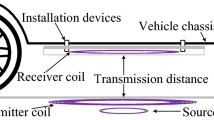Abstract
The four-coil wireless power transfer (WPT) technology can effectively improve the transfer efficiency. The high efficiency, however, cannot be obtained along the whole transfer distance due to the phenomenon of frequency splitting in the over coupled region. Aiming at this limitation, this paper presents a switchable WPT system to improve the overall efficiency by changing the number of working coils. The switching conditions for the designed system are determined based on the analysis of the transfer efficiencies of four structures, which is deduced through modeling the equivalent circuits. The simulation results well comply with the experimental results and both of them indicate that the switchable system can greatly improve the overall transfer efficiency along the whole transfer distance. The overall efficiency of the experimental system can reach above 70% at 9.97 MHz without additional complexity, which is higher than any single structure system.
Similar content being viewed by others
References
Tesla N. Apparatus for transmitting electrical energy. US patent number 1, 119, 732. 1914
Hirai J J, Kim T W, Kawamura A. Wireless transmission of power and information for cableless linear motor drive. IEEE Trans Power Electron, 2000, 15: 21–27
Jang Y, Jovanovic M M. A contactless electrical energy transmission system for portable-telephone battery chargers. IEEE Trans Ind Electron, 2003, 50: 520–527
Soljačić M, Kurs A, Karalis A, et al. Wireless power transfer via strongly coupled magnetic resonances. Sci Express, 2007, 317: 83–86
RamRakhyani A, Mirabbasi S, Chiao M. Design and optimization of resonance-based efficient wireless power delivery systems for biomedical implants. IEEE Trans Biomed Circ S, 2011, 5: 48–63
Kelly S, Shire D, Chen J, et al. A hermetic wireless subretinal neurostimulator for vision prostheses. IEEE Trans Biomed Eng, 2011, 58: 3197–3205
Cannon B, Hoburg J, Stancil D, et al. Magnetic resonant coupling as a potential means for wireless power transfer to multiple small receivers. IEEE Trans Power Electron, 2009, 24: 1819–1825
Ma G Y, Yan G Z, Wang K D, et al. Study on wireless powered microrobot for gastrointestinal detection. Robot, 2008, 30: 56–62
Imura T, Okabe H, Hori Y, et al. Basic experimental study on helical antennas of wireless power transfer for electric vehicles by using magnetic resonant couplings. In: Proceedings of Vehicle Power and Propulsion Conference. Dearborn, MI, 2009. 936–940
Ahn W, Jung S, Lee W, et al. Design of Coupled Resonators for Wireless Power Transfer to Mobile Devices using Magnetic Field Shaping. In: Proceedings of the 2012 IEEE International Symposium on Electromagnetic Compatibility. Pittsburgh, PA, 2012. 772–776
Sample A P, Meyer D T, Smith J R. Analysis, experimental results and range adaptation of magnetically coupled resonators for wireless power transfer. IEEE Trans Ind Electron, 2011, 58: 544–554
Fu W Z, Zhang B, Qiu D Y, et al. Maximum efficiency analysis and design of self-resonance coupling coils for wireless power transmission system. Proc CSEE, 2009, 29: 21–26
Qiang H, Huang X L, Tan L L, et al. Achieving maximum power transfer of inductively coupled wireless power transfer system based on dynamic tuning control. Sci China Tech Sci, 2012, 55: 1886–1893
Xue R F, Cheng K W, Je M. High-efficiency wireless power transfer for biomedical implants by optimal resonant load transformation. IEEE Trans Circuits-I, 2013, 60: 867–874
Zhang X, Ho S L, Fu W N. Quantitative design and analysis of relay resonators in wireless power transfer system. IEEE Trans Magn, 2012, 48: 4026–4029
Tan L L, Huang X L, Huang H, et al. Transfer efficiency optimal control of magnetic resonance coupled system of wireless power transfer based on frequency control. Sci China Tech Sci, 2011, 54: 1428–1434
Ye C J, Huang M X. Multi-objective optimal configuration of current limiting strategies. Sci China Tech Sci. 2014, 57: 1738–1749
Wu W P, Lu R S, Zhou X L, et al. Low-field NMR micro coils based on printed circuit board technology. Sci China Tech Sci, 2014, 57: 2082–2088
Hao L L, Wu J Y, Sun Y G, et al. Simplified mathematical model of inter-turn short circuit of field windings in hydro-generators and its application. Sci China Tech Sci, 2013, 56: 898–909
Xiao H Q, Xu Z, Xue Y L, et al. Theoretical analysis of the harmonic characteristics of modular multilevel converters. Sci China Tech Sci, 2013, 56: 2762–2770
Christ A, Douglas M G, Cooper E B, et al. Evaluation of wireless resonant power transfer systems with human electromagnetic exposure limits. IEEE Trans Electromagn C, 2013, 55: 265–274
Author information
Authors and Affiliations
Corresponding author
Rights and permissions
About this article
Cite this article
Fang, X., Liu, H., Li, G. et al. Circuit model based design and analysis for a four-structure-switchable wireless power transfer system. Sci. China Technol. Sci. 58, 534–544 (2015). https://doi.org/10.1007/s11431-014-5732-9
Received:
Accepted:
Published:
Issue Date:
DOI: https://doi.org/10.1007/s11431-014-5732-9




